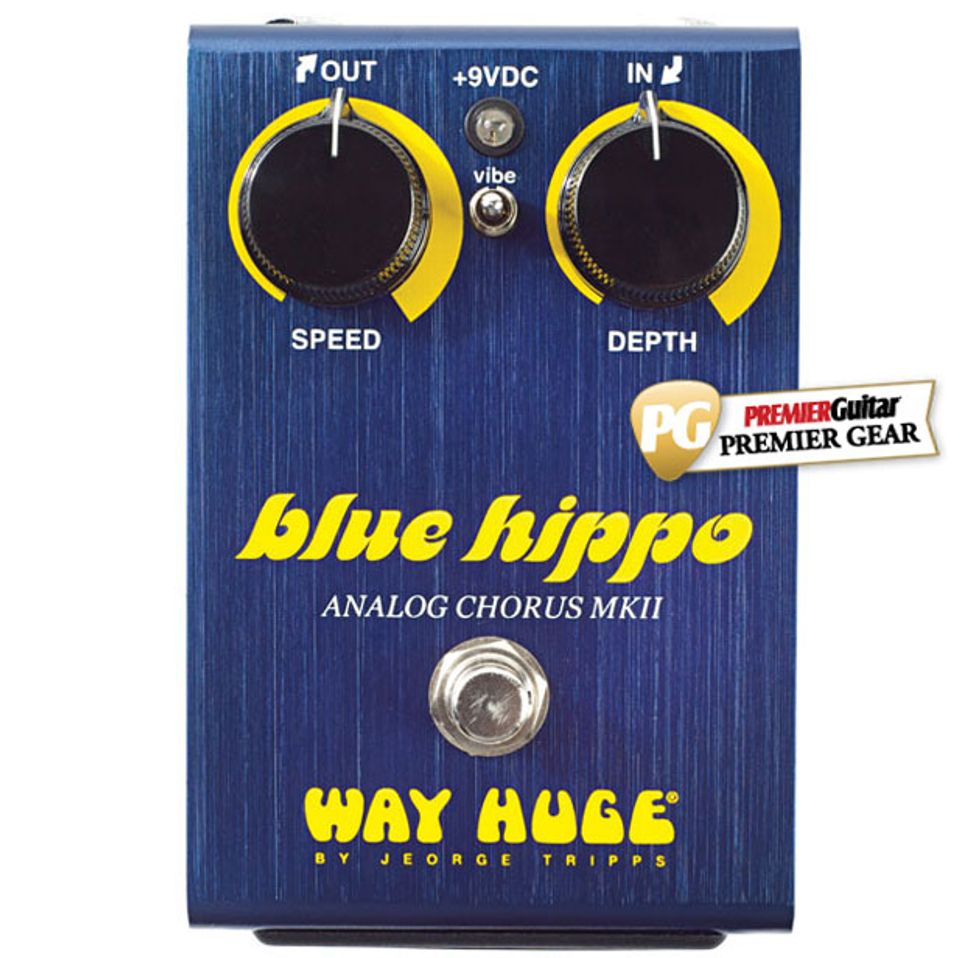
Some of Jeorge Tripps coolest circuits were based on pedals that were relatively unheralded in their day. The preposterously rare Blue Hippo, for example, was derived from the Boss CE-2, an underappreciated yet powerful chorus that has since become a sleeper classic.
The new Way Huge Blue Hippo MKII is a bucket brigade-driven analog resurrection of the original Blue Hippo, but with an added vibrato function. It’s bound to stoke fans of BBD choruses like the CE-2 and Electro-Harmonix Polychorus, as well as Way Huge devotees who missed out on the original Blue Hippo.
Buckets of Blue
At a glance you could mistake the MKII for an original Blue Hippo. The new vibe toggle switch and the blinding/blinking LED are the most overt differences. Inside, the MKII circuit reveals the sense of order and design that’s the norm for Tripp’s new Way Huge pedals. The circuit board “floats” independently from the chassis-mounted input/output jacks, while the pots, toggle, and soft-relay footswitch are attached to the board.
It’s a secure-looking design. The input, output, and 9V DC jacks are top-mounted. You can also power the pedal with a 9V battery, and the easy-access hinged door makes changes fast and easy, even if the pedal is mounted on a board.
Ratings
Pros:
Pretty, deep, and shimmering analog chorus effects with nuanced modulation curves. Hip vibrato circuit. Sounds killer with fuzz.
Cons:
None
Tones:
Ease of Use:
Build/Design:
Value:
Street:
$169
Way Huge Blue Hippo MKII
jimdunlop.com
Spun And Twisted
There’s great depth and complexity to the Blue Hippo—both in the harmonic color you hear at every point on the modulation curve, and in its subtle-to-submarine chorus textures. The sonic likeness to the original CE-2 is often uncanny. But there’s EHX Polychorus color in the mix too, especially at deep settings.
The Blue Hippo’s deep, warbly modulation is intoxicating. But I also love the subtler side of the pedal’s persona. Slow speeds and mellow depth settings in the lower third of the control’s range gave electric 12-string arpeggios extra body and a pretty touch of animation. The sonic sum can almost serve as a boost in a mix, highlighting critical high-mid content via a touch of extra motion. It’s almost counterintuitive, given how modulation effects like tremolo can create a perceived volume drop. But it works, and in a hip way that you might not immediately perceive as chorusing.
The Hippo is also a great match for fuzz. Paired with a silicon Fuzz Face clone, it did a better job communicating the swirling, unhinged soulfulness of Hendrix’s circa-’70 fuzz-plus-Uni-Vibe tones than many Uni-Vibe-inspired pedals I’ve played. The harmonic richness and nuanced modulation curves that make clean chorused tones sound so rich also excite high-mid fuzz content, adding presence rather than obscuring the signal.
The real bonus is vibe mode. While there may be more complex or versatile vibratos out there, it isn’t easy finding a BBD-driven one at an affordable price. The MKII’s vibe is beautifully deep. It can be disorienting or subtle, depending on your depth settings. It’s got shadowy authority in the lows and low-mids that adds modulation weight you just don't get from many digital vibratos.
The Verdict
With its deep chorus tones, queasy vibrato sounds, and capacity for pretty and subtle variations of both, the Blue Hippo is a chorus for folks who don’t especially like chorus. It has an expensive, sometimes sublime musical feel, minus the boutique price tag. Even for those who only occasionally use such modulation effects, it’s a small investment for so much added color.








![Rig Rundown: Russian Circles’ Mike Sullivan [2025]](https://www.premierguitar.com/media-library/youtube.jpg?id=62303631&width=1245&height=700&quality=70&coordinates=0%2C0%2C0%2C0)


























